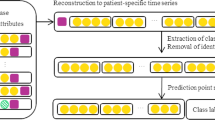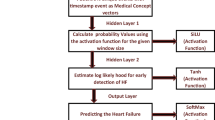Abstract
Deep learning sequential models are increasingly being used to predict patients’ health outcomes by analyzing their medical histories. In this paper, we investigate the design decisions and challenges of using deep learning sequential models for predictive health modeling. Our results show that the most successful deep learning health models to date, called transformers, lack a mechanism to analyze the temporal characteristics of health records. To address this gap, we propose and evaluate a new model called DTTHRE: Decoder Transformer for Temporally Embedded Health Records Encoding. DTTHRE analyzes patients’ medical histories, including the elapsed time between visits. We also evaluate the performance of DTTHRE on a real-world medical dataset for two health outcomes: (1) diagnostic and (2) readmission prediction. DTTHRE successfully predicted patients’ final diagnosis (78.54 ± 0.22%) and readmission risk (99.91 ± 0.02%) with improved performance compared to existing deep learning sequential models in the literature. DTTHRE predicts the health outcome for each medical visit, which increases the training examples available from limited medical datasets with no additional training time.
Access this chapter
Tax calculation will be finalised at checkout
Purchases are for personal use only
Similar content being viewed by others
References
Bellos, C., Papadopoulos, A., Rosso, R., Fotiadis, D.I.: Heterogeneous data fusion and intelligent techniques embedded in a mobile application for real-time chronic disease management. In: International Conference of the IEEE Engineering in Medicine and Biology Society (EMBS-11) (2011). https://doi.org/10.1109/IEMBS.2011.6092047
Boursalie, O., Samavi, R., Doyle, T.E.: Machine learning and mobile health monitoring platforms: a case study on research and implementation challenges. J. Healthc. Inf. Res. 2(1) (2018). https://doi.org/10.1007/s41666-018-0021-1
Boursalie, O., Samavi, R., Doyle, T.E.: Decoder transformer for temporally-embedded health outcome predictions. In: IEEE The 20th International Conference on Machine Learning and Applications (ICMLA-21) (2021). https://doi.org/10.1109/ICMLA52953.2021.00235
Boursalie, O., Samavi, R., Doyle, T.E.: Evaluation metrics for deep learning imputation models. In: AAAI The 5th International Workshop on Health Intelligence (W3PHIAI-21) (2021). https://doi.org/10.1007/978-3-030-93080-6_22
Boursalie, O., Samavi, R., Doyle, T.E., Koff, D.A.: Deep learning model for cancer risk from low dose medical imaging radiation. In: European Congress of Radiology (ECR) (2020). https://doi.org/10.26044/esi2020/ESI-10315
Boursalie, O., Samavi, R., Doyle, T.E., Koff, D.A.: Using medical imaging effective dose in deep learning models: estimation & evaluation. IEEE Trans. Radiat. Plasma. Med. Sci. (2020). https://doi.org/10.1109/TRPMS.2020.3029038
Canadian Institute for Health Information (CIHI): Canadian Coding Standards for Version 2010 ICD-10-CA and CCI. Technical Report (2010)
Canadian Nuclear Safety Commission (CNSC): In: Radiation Doses (2020). https://www.cnsc-ccsn.gc.ca/eng/resources/research/index.cfm
Choi, E., Bahadori, M.T., Schuetz, A., Stewart, W.F., Sun, J.: Doctor AI: predicting clinical events via recurrent neural networks. In: Machine Learning for Healthcare Conference (MLHC-16). PMLR (2016)
Choi, E., Bahadori, M.T., Sun, J., Kulas, J., Schuetz, A., Stewart, W.: Retain: an interpretable predictive model for healthcare using reverse time attention mechanism. In: Advances in Neural Information Processing Systems (NeurIPS-16), vol. 29 (2016)
Choi, E., Xiao, C., Stewart, W., Sun, J.: MiME: multilevel medical embedding of EHR for predictive healthcare. In: 32nd Conference on Neural Information Processing Systems (NeurIPS-18) (2018). https://papers.nips.cc/paper/2018/file/934b535800b1cba8f96a5d72f72f1611-Paper.pdf
Comito, C., Forestiero, A., Papuzzo, G.: Exploiting social media to enhance clinical decision support. In: International Joint Conference on Web Intelligence and Intelligent Agent Technology (WI-IAT-19) (2019). https://doi.org/10.1145/3358695.3360899
Devlin, J., Chang, M.W., Lee, K., Toutanova, K.: BERT: pre-training of deep bidirectional transformers for language understanding. In: North American Chapter of the Association for Computational Linguistics (NAACL) (2019). https://aclanthology.org/N19-1423.pdf
Dietterich, T.G.: Machine learning for sequential data: a review. In: Joint IAPR International Workshops on Statistical Techniques in Pattern Recognition (SPR) and Structural and Syntactic Pattern Recognition (SSPR) (2002). https://doi.org/10.1007/3-540-70659-3_2
Esfandiari, N., Babavalian, M.R., Moghadam, A.M.E., Tabar, V.K.: Knowledge discovery in medicine: current issue and future trend. Expert Syst. Appl. 41(9) (2014). https://doi.org/10.1016/j.eswa.2014.01.011
Fawaz, H.I., Forestier, G., Weber, J., Idoumghar, L., Muller, P.A.: Data augmentation using synthetic data for time series classification with deep residual networks. In: ECML/PKDD Workshop on Advanced Analytics and Learning on Temporal Data (AALTD-18) (2018). https://arxiv.org/pdf/1808.02455.pdf
Hochreiter, S., Schmidhuber, J.: Long short-term memory. Neural Comput. 9(8) (1997). https://doi.org/10.1162/neco.1997.9.8.1735
Huang, C., Vaswani, A., Uszkoreit, J., Shazeer, N., Simon, I., Hawthorne, C., Dai, A.M., Hoffman, M.D., Dinculescu, M., Eck, D.: Music transformer. In: International Conference on Learning Representations (ICLR-19) (2019). https://openreview.net/pdf?id=rJe4ShAcF7
Huang, M., Zolnoori, M., Shah, N.D., Yao, L.: Temporal sequence alignment in EHR for patient representation. In: IEEE International Conference on Bioinformatics and Biomedicine (BIBM-18) (2018). https://doi.org/10.1109/BIBM.2018.8621428
International Commission on Radiology Protection (ICRP): The 2007 Recommendations of the ICRP. ICRP Publication 103, vol. 37, no. (2–4) (2007)
Johnson, A.E., Pollard, T.J., Shen, L., Li-Wei, H.L., Feng, M., Ghassemi, M., Moody, B., Szolovits, P., Celi, L.A., Mark, R.G.: MIMIC-III, a freely accessible critical care database. Sci. Data 3(1) (2016). https://doi.org/10.1038/sdata.2016.35
Kingma, D.P., Ba, J.: Adam: a method for stochastic optimization. In: International Conference on Learning Representations (ICLR-15) (2015). https://arxiv.org/abs/1412.6980
Li, Y., Rao, S., Solares, J.R.A., Hassaine, A., Ramakrishnan, R., Canoy, D., Zhu, Y., Rahimi, K., Salimi-Khorshidi, G.: BEHRT: transformer for EHR. Nat. Sci. Rep. 10(1) (2020). https://doi.org/10.1038/s41598-020-62922-y
Lin, E.C.: Radiation risk from medical imaging. Mayo Clin. Proc. 85(12) (2010). https://doi.org/10.4065/mcp.2010.0260
Liu, M., Jiang, M., Kawai, V.K., Stein, C.M., Roden, D.M., Denny, J.C., Xu, H.: Modeling drug exposure data in electronic medical records: an application to Warfarin. In: American Medical Informatics Association Symposium (2011). https://europepmc.org/articles/PMC3243123
Miotto, R., Li, L., Kidd, B.A., Dudley, J.T.: Deep patient: an unsupervised representation to predict the future of patients from the EHR. Nat. Sci. Rep. 6(1) (2016). https://doi.org/10.1038/srep26094
Mirtchouk, M., Srikishan, B., Kleinberg, S.: Hierarchical information criterion for variable abstraction. In: Machine Learning for Healthcare (MLHC-21) (2021). http://www.healthailab.org/papers/21MLHC.pdf
National Research Council: Health Risks from Exposure to Low Levels of Ionizing Radiation: BEIR VII Phase 2, vol. 7. National Academies Press (2006)
Nguyen, P., Tran, T., Wickramasinghe, N., Venkatesh, S.: Deepr: a convolutional net for medical records. IEEE J. Biomed. Health Inf. 21(1), 22–30 (2016)
Oore, S., Simon, I., Dieleman, S., Eck, D., Simonyan, K.: This time with feeling: learning expressive musical performance. Neural. Comput. Appl. 32(4) (2020). https://doi.org/10.1007/s00521-018-3758-9
Pham, T., Tran, T., Phung, D., Venkatesh, S.: DeepCare: a deep dynamic memory model for predictive medicine. In: Advances in Knowledge Discovery and Data Mining (AKDD-16) (2016). https://doi.org/10.1007/978-3-319-31750-2_3
Radford, A., Wu, J., Child, R., Luan, D., Amodei, D., Sutskever, I.: Language Models are Unsupervised Multitask Learners. Technical Report (2019)
Rasmy, L., Xiang, Y., Xie, Z., Tao, C., Zhi, D.: Med-BERT: pretrained contextualized embeddings on large-scale structured EHR for disease prediction. npj Digit. Med. 4(1) (2021). https://doi.org/10.1038/s41746-021-00455-y
Rumelhart, D.E., Hinton, G.E., Williams, R.J.: Learning Internal Representations by Error Propagation. Technical Report, University of California San Diego (1985). https://apps.dtic.mil/sti/citations/ADA164453
Schäfer, P.: Scalable time series classification. Data Min. Knowl. Discov. 30(5) (2016). https://doi.org/10.1007/s10618-015-0441-y
Shickel, B., Tighe, P.J., Bihorac, A., Rashidi, P.: Deep EHR: a survey of recent advances in deep learning techniques for EHR analysis. IEEE J. Biomed. Health Inf. 22(5) (2018). https://doi.org/10.1109/JBHI.2017.2767063
Teo, K., Yong, C.W., Chuah, J.H., Hum, Y.C., Tee, Y.K., Xia, K., Lai, K.W.: Current trends in readmission prediction: an overview of approaches. Arab. J. Sci. Eng. (2021). https://doi.org/10.1007/s13369-021-06040-5
Vaswani, A., Shazeer, N., Parmar, N., Uszkoreit, J., Jones, L., Gomez, A.N., Kaiser, L., Polosukhin, I.: Attention is all you need. In: Conference on Neural Information Processing Systems (NeurIPS-17) (2017)
Vig, J.: A multiscale visualization of attention in the transformer model. In: 57th Annual Meeting of the Association for Computational Linguistics (ACL-19) (2019). https://aclanthology.org/P19-3007.pdf
Vitolo, C., Scutari, M., Ghalaieny, M., Tucker, A., Russell, A.: Modeling air pollution, climate, and health data using Bayesian networks: a case study of the english regions. Earth Space Sci. 5(4) (2018). https://doi.org/10.1002/2017EA000326
Wolf, T., Chaumond, J., Debut, L., Sanh, V., Delangue, C., Moi, A., Cistac, P., Funtowicz, M., Davison, J., Shleifer, S., Platen, V.P., Ma, C., Jernite, Y., Plu, J., Xu, C., Le Scao, T., Gugger, S., Drame, M., Lhoest, Q., Rush, A.: Transformers: state-of-the-art natural language processing. In: Empirical Methods in Natural Language Processing (EMNLP-20) (2020). https://aclanthology.org/2020.emnlp-demos.6/
World Health Organization (WHO): Anatomical Therapeutic Chemical (ATC) Toolkit. Technical Report (2021)
Xiao, C., Choi, E., Sun, J.: Opportunities & challenges in developing deep learning models using EHR data: a review. J. Am. Med. Inf. Assoc. 25(10) (2018). https://doi.org/10.1093/jamia/ocy068
Acknowledgements
This work was supported by the Natural Sciences and Engineering Research Council of Canada, Southern Ontario Smart Computing Innovation Platform, and Canadian Department of National Defence: Innovation for Defence Excellence and Security Program.
Author information
Authors and Affiliations
Corresponding author
Editor information
Editors and Affiliations
Appendices
Appendix: A
In this appendix, an overview of the dataset used in this study is provided. Tables 7 and 8 describe the types of medical data available. Next, the breakdown of records from each data source is shown in Table 9. Then, Table 10 describes the characteristics of the patient population recorded in the dataset.
Appendix: B
In this appendix, the frequency of the thirty most frequent diagnostic and visit-level THRE encoding elements for E1 (Table 11) and E2 (Table 12) is presented.
Rights and permissions
Copyright information
© 2023 The Author(s), under exclusive license to Springer Nature Singapore Pte Ltd.
About this chapter
Cite this chapter
Boursalie, O., Samavi, R., Doyle, T.E. (2023). Evaluation of Sequential and Temporally Embedded Deep Learning Models for Health Outcome Prediction. In: Wani, M.A., Palade , V. (eds) Deep Learning Applications, Volume 4. Advances in Intelligent Systems and Computing, vol 1434. Springer, Singapore. https://doi.org/10.1007/978-981-19-6153-3_2
Download citation
DOI: https://doi.org/10.1007/978-981-19-6153-3_2
Published:
Publisher Name: Springer, Singapore
Print ISBN: 978-981-19-6152-6
Online ISBN: 978-981-19-6153-3
eBook Packages: Intelligent Technologies and RoboticsIntelligent Technologies and Robotics (R0)




